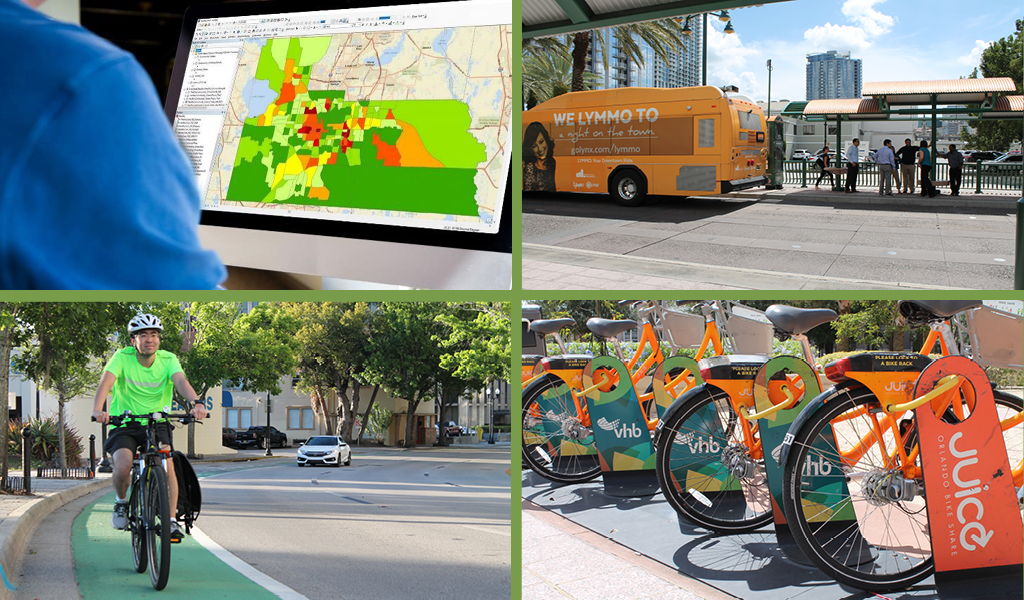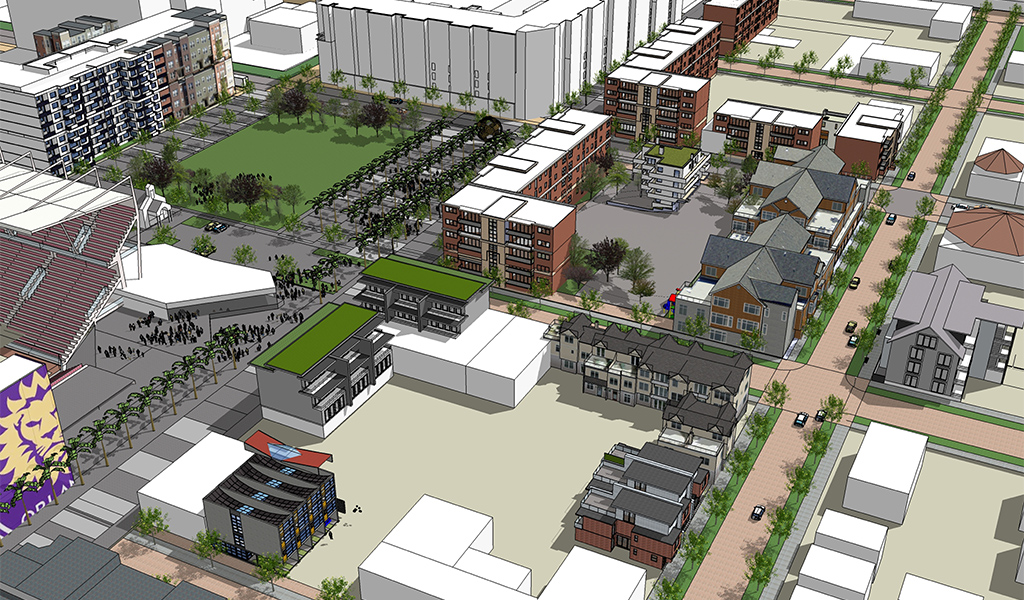The connection between community health and the built environment has long been understood. Where we live, work, and play has an enormous impact on our health and well-being. Communities that are designed in a way that supports physical activity—a network of complete streets with sidewalks, bike lanes, street trees, and plantings, access to transit, active recreation and healthy food choices—encourage and support residents to make healthy choices and live healthy lives. Increased access to green space promotes more frequent social and physical activity, while multimodal transportation options allow for better connectivity to affordable housing and economic opportunity.
Integrating health into our communities through planning, policy, and design has the potential to enrich—and save—lives. Today, more than ever, industry leaders must focus on incorporating healthy community design (HCD) principles into our planning and design work to ensure that infrastructure investments have a positive impact on the health and sustainability of our communities—now and in the future. Transportation plays a big part in this.
Social Determinants Drive Health Status

The Foundation for Healthy Community Design
As described in FHWA’s Metropolitan Area Transportation Planning for Healthy Communities, transportation significantly influences physical activity and well-being, safety, and the ability of a community to access destinations that are essential to living a healthy lifestyle. Expanding access to transportation options and integrating health-enhancing choices in the planning and development process can improve the many health-related issues that municipalities encounter, while also stimulating economic development and providing improved access. Applying HCD principles to the planning and design of transportation infrastructure results in a more holistic, sustainable solution that is focused on the needs of the community and the people whom the infrastructure is designed to serve.
The 10 principles of Healthy Community Design:
- Maximize opportunity for physical activity
- Increase housing opportunities for all income levels
- Promote a healthy environment and social well-being
- Empower champions for healthy community
- Encourage mixed-use development
- Make education the foundation of community development and redevelopment
- Improve access to job opportunities
- Invest in active transportation solutions
- Promote access to healthy food
- Drive economic development
Partnerships for Holistic Design
An essential tenet of HCD is bringing together a diverse set of stakeholders from multiple disciplines. This approach requires partners from all backgrounds, including planning, design, engineering, and health care specialists, to work together in collecting data and developing tools that can be used in analyzing the role that transportation plays in promoting better health outcomes and, ultimately, improving our transportation systems to alleviate negative health effects. Intentional coordination between disciplines may require agencies to develop a “Health in All Policies” approach, including the integration of public health into Complete Streets policies.
The purpose of planning for communities and their residents is to connect people not just to each other, but to the services and destinations that are critical for their physical and mental health. Whereas health care practitioners are involved with treating symptoms of a disease—often when it’s too late—planners and engineers are engaged early on by designing the built environment in ways that promote active lifestyles and better health. A/E/C professionals should involve public health officials and practitioners early in the process to improve health outcomes, particularly within underrepresented populations and communities.
Measuring Health Impacts
Health-based metrics are an important part of making the case for HCD. Whether quantitative or qualitative, data is a powerful tool in the decision-making process. Community health data is commonly available at the regional or county-wide scale, however most transportation projects occur in suburban settings and along corridors. It is important to find localized data to determine if a project has a positive or negative impact on the health of a community. Measuring the impacts of transportation on health is important to gain further information and lessons learned.
Strengthening linkages between transportation and health data is an important priority for agencies looking to improve safety. In addition, planners can look at social determinants of health to identify communities that may be vulnerable to health impacts, but otherwise may be overlooked when health is not a deliberate consideration. Underserved populations are often overrepresented in indicators of poor health, such as obesity, diabetes, asthma, and other chronic diseases. It is important to note that income levels are not the only indicator of health outcomes, as many affluent communities also suffer from poor urban design, as well as land use and mobility choices that discourage physical activity and social interaction.
We need data to describe vulnerabilities within our designs, yet attaining community health data can be difficult. There are few models that measure the relationship between transportation and health. Those that are available are not scalable to the neighborhood or corridor. New platforms that are customizable and can measure physical activity from active transport are crucial tools when planning for healthy transportation options.
Healthy Mobility model
VHB is developing a “Healthy Mobility” tool that correlates land use, urban design, and transportation factors in assessing the built environment’s impact on public health. As localized health data (sub-county level) can be difficult to obtain, VHB used technology and big data to correlate available demographic, urban design, and transportation data with published health data (CDC 500 Cities Project) at the census-tract level. The outcome is a community health profile at the census-tract level, which allows for neighborhood or corridor planning at a localized level.
The Healthy Mobility model uses an ordinary least squares (OLS) regression analysis to provide quantitative results about which urban design and mobility factors have the most significant statistical correlation with improved health outcomes. The tool can help planners and decision-makers recommend or prioritize physical improvements that will have the greatest contributions to improved community health.
The model will continue to be refined by expanding the data to include additional values and parameters, as well as expand into larger geographic coverage. The end goal will be to use big data and machine learning to find relationships between various transportation investments and health that haven’t yet been considered.

VHB is advancing the cause of health in transportation by planning, designing, and building communities in a way that impacts individual and community health. Our understanding of the relationship between transportation, urban design, and health affords us a unique perspective as we partner with clients and lead the way in developing and implementing tools and solutions for healthy communities, including:
- Developing, with the City of Orlando, the Parramore Comprehensive Neighborhood Plan. All recommendations and actions were organized by the 10 HCD principles, including emphasizing safety, social engagement, and community activism while balancing preservation of cultural heritage with economic development.
- Partnering with the University of North Carolina, Highway Safety Research Center, on the development of a research roadmap for better integrating health into transportation decisions and activities. The NCHRP 20-112 Health and Transportation Strategic Research Roadmap will identify gaps in existing national research and develop summary descriptions for future research. One theme for future research looks for refined models to estimate impacts of transportation decisions on public health, and another seeks formal guidance for collaboration between transportation and public health officials.
- Designing The Grow, a mixed-use, 1,200-acre, master planned ”Agrihood” located in Orlando, Florida, based on agriculture and recreation. Primary design decisions are based on walkability, including 12 miles of trails, bikes lanes, and pedestrian facilities connecting the neighborhoods to retail, the farm, gardens, the elementary school, a 13-acre lake-front community park, equestrian center, as well as off-site trails and other, nearby neighborhoods.
- Working with the Massachusetts Department of Transportation to develop a Complete Streets plan for the Arsenal Street Corridor, a major local and regional arterial running through eastern Watertown, Massachusetts. Study elements include improved pedestrian and bicycle connectivity, enhanced transit service/accessibility, and incorporation of measures to improve public health.

How VHB Can help
HCD is important to VHB; it encompasses who we are and what we do. We are committed to including HCD principles into the projects that could benefit from it most, creating economically thriving communities that put health and well-being at the forefront. VHB has conducted HCD-focused symposiums in Orlando, Boston, and Washington, D.C. aimed at examining how we can incorporate HCD principles into the planning and design of our transportation infrastructure. We have taken our experiences with local and national experts, and lessons learned from the symposiums to shape our work. To learn more about our integrated services approach that positions us to effectively plan and design healthy communities, contact Lauren Blackburn or Curt Ostrodka.




